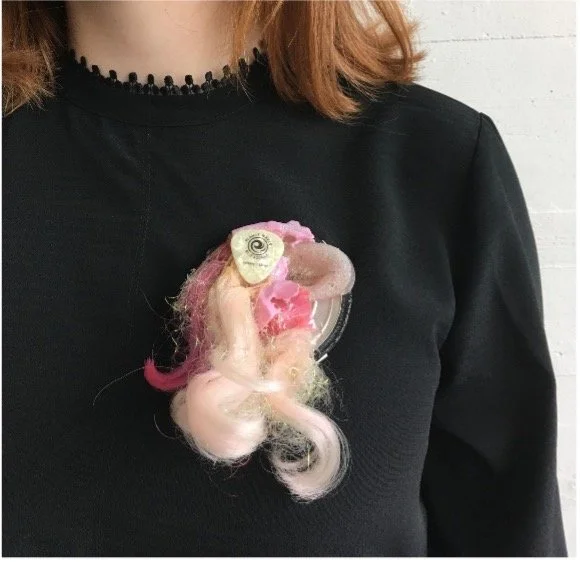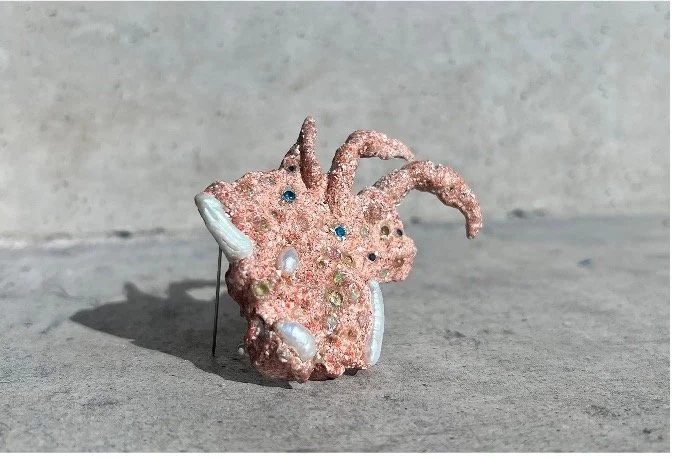Spot the Designer - Samantha Sloane/ UK
What did you want to be when you were a child?
When I was younger, I was unsure what I wanted to be when I was older. I remember saying that I wanted to be a farmer as I adored horses. I always loved undertaking creative activities and did better in art and design at school, but I didn’t understand how or what I could pursue in that field; despite my dad being a stained -glass artist.
When have you started creating jewelry? How did this passion come about?
Around the age of 17 I knew I wanted to design for the body. My fashion designs were always very sculptural, that used interesting materials and incorporated metal. I had experience assembling stained glass panels which added to my material knowledge; however, I was oblivious that my work could have been considered jewellery at that time.
What was your first project or significant piece for you and from what point of view?
I made a brooch in my second year at art school inspired by the theme of value and repurposing objects that once played an important role in my life but did not anymore. The materials I used ranged from old toys such as My Little Pony’s, make up packaging and guitar picks; a fusion of items that have shaped my identity. It was the first project that made me question my own idea of preciousness and inspired me to design wearable objects that embodied my life experiences.
How do you charge your batteries? What other passions and creative interests do you have?
I love cooking and trying new recipes, either alone or with my friends. Music has always been a big passion of mine and I enjoy seeing bands live, as I am interested with how people interact with objects to create something amazing that impacts others in a positive way. I also enjoy long walks along coastlines as they are familiar and I get to be amongst nature and ponder ideas.
What does the connection between manufacturing tradition and contemporary design mean to you?
I think a lot of people worry about doing things that “have been done before”, wither that is a technique or using common subject matter. I think it’s good to take inspiration from previous makers/artists and respect what has been explored before, however it is up to us as to think of new ways to explore these ideas further. Contemporary jewellery design is so vast and here is room for everybody; we should take what we know and explore how we can make it authentic and our own, in my opinion.
Is there a self-portrait piece that speaks most about you?
As I continue to develop my practise and design objects with claws/alien like forms, I feel I resonate with them more and more. Not only are they nostalgic to make when sourcing materials, they can be fun and mysterious creatures that make you want to find out more about them. They come in a variety of colours through careful pigment combination, and include a range of precious/semi-precious stones to fakes. The pieces are multifaceted and suits many different tastes, which I think sums me up. Images of new work below.
Which material have you not yet used is a temptation and a challenge for you?
I have never used solid gold in my work as I enjoy silver and prefer it aesthetically – however it would be interesting to see if there is much difference when melting it down or using it to cast on the beach. I would also love to incorporate diamonds into my work as I like the idea of juxtaposing fakes with real gemstones.
How was the pandemic period for you as a jewelry designer?
During the peak of the pandemic, I was transitioning from my 2nd year to 3rd year at The Glasgow School of Art. I was lucky enough to be at my family home for some of it, which was where I found a lot of my inspiration to use shell as a material. It was difficult to learn some of the techniques we would have been taught in the workshop; however, it pushed us to use our initiative and improvise with what materials/facilities we had available.
How do you see the future of contemporary jewelry?
Due to climate change and the cost-of- living crisis, I think as more people nowadays are becoming more conscious of what they consume; people want to know what they’re buying and why. Jewellery is definitely a luxury, however I believe that art jewellery can be enjoyed without purchasing it, as it acts as a conversation starter and can create memorable experiences for viewers. I think the future of contemporary jewellery looks bright as people are always intrigued and want to know more about the motives behind the work. As artists, we should make it accessible for the general public to be involved in our world, which will (hopefully) continue to inspire others to create something of their own.
Find more about the designer Samantha Sloane




